
Gorm the Old, also called Gorm the Languid, was ruler of Denmark, reigning from c. 936 to his death c. 958 or a few years later. He ruled from Jelling, and made the oldest of the Jelling stones in honour of his wife Thyra. Gorm was born before 900 and died perhaps around 958 or possibly 963 or 964.
Richeza of Poland, a member of the House of Piast, was twice Queen of Sweden and once Princess of Minsk through her three marriages. Tradition describes her as unusually beautiful.

Sweyn II, also known as Sweyn Estridsson and Sweyn Ulfsson, was King of Denmark from 1047 until his death in 1076. He was the son of Ulf Thorgilsson and Estrid Svendsdatter, and the grandson of Sweyn Forkbeard through his mother's line. He was married at least two times, and fathered 20 children or more out of wedlock, including the five future kings Harald Hen, Saint Canute, Oluf Hunger, Eric Evergood, and Niels.

Eric IV, also known as Eric Ploughpenny or Eric Plowpenny, was King of Denmark from 1241 until his death in 1250. His reign was marked by conflict and civil wars against his brothers.

Olaf I, nicknamed Olaf Hunger, was king of Denmark from 1086 to 1095, following the death of his brother Canute IV the Holy. He was a son of king Sweyn II Estridsson, and the third of Sweyn's sons to rule. He married Ingegard, the daughter of Harald Hardråde, but did not have any sons. He was succeeded by his brother Eric the Good.

Eric I, also known as Eric the Good, was King of Denmark following his brother Olaf I Hunger in 1095. He was a son of Sweyn II. His mother's identity remains unknown. He married Boedil Thurgotsdatter.
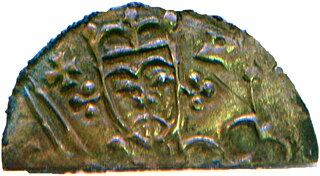
Niels was the King of Denmark from 1104 to 1134. Niels succeeded his brother Eric Evergood and is presumed to have been the youngest son of King Sweyn II Estridson. King Niels actively supported the canonization of Canute IV the Holy and supported his son Magnus after he killed his rival for the succession, Knud Lavard. His secular rule was supported by the clergy. Niels was killed in an ensuing civil war and succeeded by Eric II Emune.
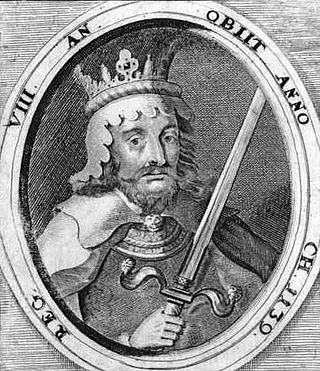
Eric II the Memorable was king of Denmark between 1134 and 1137. Eric was an illegitimate son of Eric I of Denmark, who ruled Denmark from 1095 to 1103. Eric the Memorable rebelled against his uncle Niels of Denmark, and was declared king in 1134. He punished his adversaries severely, and rewarded his supporters handsomely. He was killed by a subject in 1137 and was promptly succeeded by his nephew Eric III of Denmark.
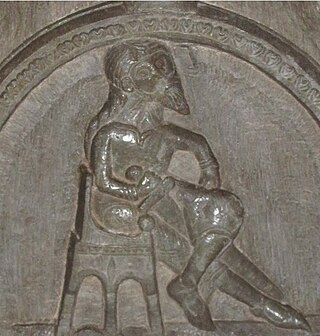
Sverker the Elder, also known as Sverker I, was King of Sweden from about 1132 until his murder. Of non-royal descent, he founded the House of Sverker, the rulers of which alternated with the rival House of Erik over the next century.
Magnus the Strong, also known as Magnus Nilsson, was a Danish duke who ruled Götaland in southern Sweden from the 1120s to c. 1132. It is disputed whether he was elected king by the Swedes, but he is nevertheless sometimes found in the modern list of Swedish monarchs as Magnus I. Snorri Sturlason gives him the epithet "Strong".

The Battle of Grathe Heath was fought in 1157 between the Danish armies of Valdemar I and his rival for the Danish throne, Sweyn III. Valdemar's forces won the battle, and Sweyn III was slain while attempting to flee.

Horik II, also known as Hårik or, in late sources, Erik Barn, was King of the Danes from the fall of Horik I in 854 to an unknown date between 864 and 873. During his reign the Danish kingdom showed tendencies of breaking up. After his demise under unknown circumstances, Denmark entered a long period of obscurity, until the rise of the Jelling dynasty in the 10th century.
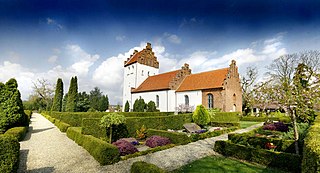
Skjalm Hvide, was the Earl of Zealand in Denmark in the end of the Viking Age (793–1066) and up to his death. Skjalm's father was Toke Trylle, whose father was Slag, based on Absalon, a medieval account scanned, translated and published by Google.
Henrik Svendsen, better known as Henrik Skadelår or Henrik the Lame, was a Danish prince and pretender through his father, Svend Tronkræver, an illegitimate son of King Sweyn II. He died in the Battle of Fotevik before he could press his claim.

The Danish Civil Wars were a series of civil wars fought in the Kingdom of Denmark, first from 1131 to 1134 over the murder of Canute Lavard, then from 1139 to 1143, and finally a war of succession fought from 1146 to 1157, after the abdication of Eric III of Denmark, the first monarch in Danish history to have abdicated. The first phase of the war was fought between King Eric II of Denmark and King Niels joined by Magnus the Strong. The second phase of the war was fought between the son of Magnus the Strong, Canute V of Denmark, the son of Eric II of Denmark, Sweyn III of Denmark, and his cousin Valdemar I of Denmark, son of Canute Lavard. The civil wars marked an increase in the influence of the Holy Roman Empire in Denmark, and for a time after, Denmark was a vassal state of Emperor Frederick I. The war ended with the deaths of seven kings. Two of the kings, Olaf Haraldsen and Magnus the Strong, are not amongst the official Danish line of kings. The other kings are Niels I, Eric II, Eric III, Canute V and Sweyn III.
The Battle of Værebro took place in the year 1133 at the Værebro river, on the isle of Zealand.
The battle of Sejerø was a naval battle fought in 1132, near the Island of Sejerø by the Zealandic coast. A zealandic and scanian fleet under Eric II fought a jutlandic fleet under Magnus the Strong. Eric defeated Magnus completely, all that was salvaged from the defeat was the boat Magnus escaped in, the battle was the first defeat dealt to the Niels-Magnus party.
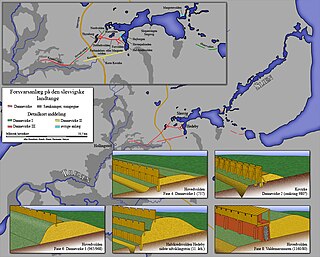
The siege of Schleswig took place from 1131–1132 during the Danish Civil Wars. It saw forces under the Eric II of Denmark, Holy Roman Emperor Lothair III, and Adolf of Holstein face off against Niels I of Denmark and his son Magnus the Strong of Götaland. Eric failed to break the siege, as he was deserted by Lothair III after he came to an agreement with Magnus and Niels. Only Adolf of Holstein remained with Eric, but his forces were destroyed trying to cross the Eider.
Events from the 12th century in Denmark.

The Valdemarian Age commonly also referred to as the Valdemars refers to a 84-year long period in Danish history between 1157 and 1241, beginning with the reign of Valdemar I, and ending with the death of Valdemar II. The period is heavily centered around the Danish Crusades in the Baltic Sea.













